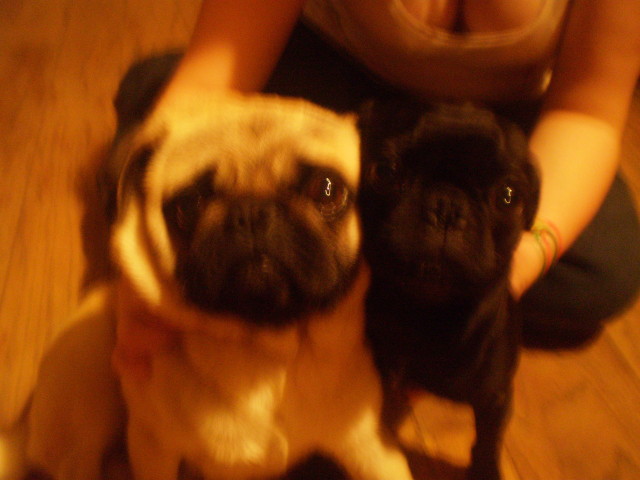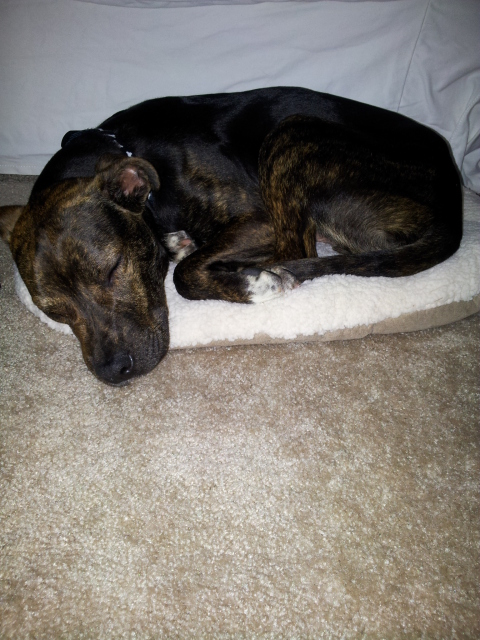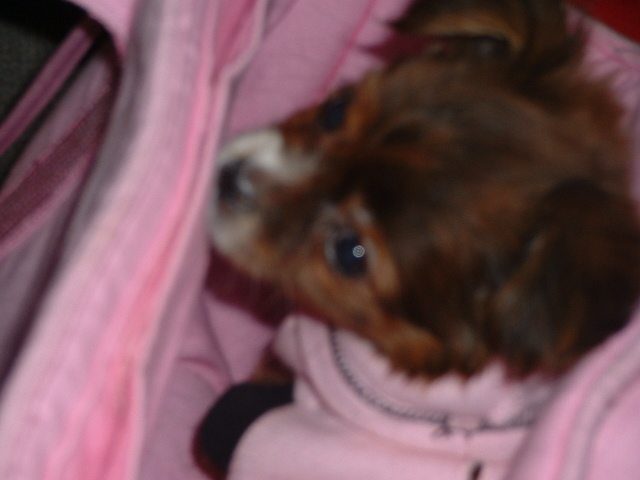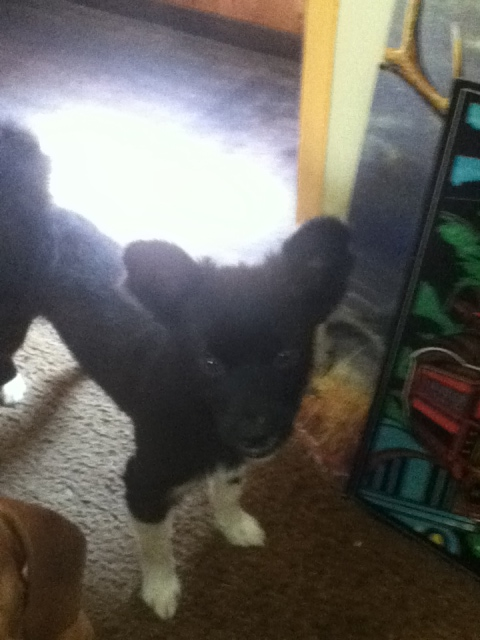QuestionHello!
My husband and I have a 3.5 year old black lab doberman mix (we
think -
we're guessing her breed based on how she looks) named Ruthy. We
got her
from the Humane Society when she was 1. She is a very high energy
happy
dog. We walk her once or twice a day and bring her to the dog park as
often
as we can but its not usually more than once or twice a month.
We've been working on making her walk beside us. If there are no
distractions
she is usually very good and will walk alongside with no problems.
However,
if there is a cat, squirrel or another dog that she wants to run towards
she will
pull and whine and this can escalate into a temper tantrum where she
pulls
back, rears up, and grabs the leash in her mouth.
Sometimes when we approach other dogs she goes into "stealth" mode
where
she will stalk the dog like a cat and then lay down and jump up when
the dog
gets closer. She is completely indistractable when she does this; she
goes
into a zone.
We walk her using a gentle leader and a couple times the clasp has
broke
open when she was pulling back and she ran over to the other dog that
she
was freaking out about. They were always happy friendly greetings,
even to a
couple of dogs whos owner said his dogs were usually aggressive.
(Now we
have a back-up clip incase the gentle lead snaps off again). Not
surprisingly,
the freak-outs have become more common since those "rewards".
I can tell when shes is in a crazy freak-out state of mind but shes in a
weird
zone where everything has her rapt attention (except me of course)
and she is
seemingly indistractable.
She is somewhat better if she has been to the dog park recently but
that
doesn't prevent the freak-outs. She did get into a fight at the dog park
once
where she bit a dog and we asked a dog trainer who specializes in
aggressive
dogs to come with us to the dog park. The trainer said she she wasn't
"aggressive" and told us to give Ruthy time-outs for bad behavior at
the park
and that we could use a basket muzzle if that made us feel more
comforable.
Both suggestions were very good and I even take the muzzle off her if
she is
behaving expecially well at the dog park.
One more thing, Ruthy seems to walk much better with my husband
than me.
She naturally walks next to him, even on a totally loose leash, and
freaks-out
much less. However, if my husband and I walk her together she is
musch
worse; constantly pulling and whining and freaking-out a lot.
How can snap her out of the zone when she goes into it and what
should I do
during her freak-outs? I'm reluctant to use a prong or choker collar
because
when she freaks out she pulls so hard I'm afraid those may injure her.
Thanks for your help! Please let me know if you need anymore
information!
AnswerHello, Ami. What a fun one you have there! My dog acted very similarly to the way your Ruthy is acting now (even down to the 'stalking' behavior!), but my dog was just 1 1/2 when she started. She's now 4, and I can walk her on a flat collar, or with no leash at all, around other dogs and she does not move from my side until I release her. I do not let her approach or play with dogs that I do not know.
You say you currently walk her on a Gentle Leader, but are reluctant to use a prong or choke collar for fear of hurting her. Well, I totally agree with you when it comes to using a choke collar. I believe choke collars are the most inhumane training tool on the market today, and it's scary to me to know that IT is the collar that most of the general public uses. Choke collars can (and do) cause injury, sometimes short term and sometimes long term, to dogs, and I absolutely despise them. On the other hand, you run more of a risk of hurting Ruthy with the Gentle Leader when she jumps or lunges towards another dog, cat, squirrel, etc. than you would with a prong collar. With a Gentle Leader, when the dog pulls, his head is pulled to the side, supposedly stopping the pulling. Most dogs that I have seen have learned to just brace against it and pull anyways, with their head sideways. If a dog wearing a Gentle Leader lunges or otherwise suddenly jerks the leash, his head can be violently whipped around sideways, and this can potentially cause spinal injury. On a prong collar, when properly fitted, if you administer a correction, or the dog pulls on the leash, the 'force' is distributed all the way around the dog's neck, in a pinching fashion, which simulates the way another dog would correct by nipping the offender's neck. This is why the prong collar is also called a pinch collar. It does not jab or stab into the dog's neck, unless it is too loose, and it does not cause pain.
What I would recommend is getting her a prong collar in small or medium. I like the Hamilton Sterling brand that is sold at Superpetz. I do not like the kind that is sold at PetsMart because they have a quick release and I know of several cases where the quick release has come apart much like your Gentle Leader, and the collar has come off the dog completely. Additionally, this quick release can make putting the collar on very difficult, especially if you have a squirmy dog! I prefer just the plain old prong collar without the quick release snap. When fitted correctly, the collar should be as high up on the dog's neck as possible - right behind the ears. It should be snug, so that the chain lies flat against the neck and does not hang down, but should not restrict breathing. The collar should not move around freely on the dog's neck. A loose collar is ineffective and, as I mentioned earlier, can jab into the neck when the leash is pulled tight. The following web page has pictures of what the prong collar should look like when correctly fitted:
http://www.leerburg.com/fit-prong.htm
This is a good article about prong collars: http://www.dru.org/prongcollar.htm
I do not like to use the so-called 'dead ring' on a prong collar, because in my opinion, it does not allow the collar to move when the leash is pulled, and so again it just jabs into the dog's neck instead of doing what it's supposed to do. If you're going to use the dead ring, you might as well just have the collar loose on your dog's neck - it's not going to be effective. You can buy rubberlike tips to go over the ends of the prongs to make the collar more comfortable for your dog to wear. These tips do not affect the collar's effectiveness. You can also take an old sock and cut the toe out of it, and put the collar through the sock. This makes it more comfortable for the dog, and also works well to hide the collar from uneducated people who might make dirty comments about it. You might have to use a safety pin to hold the two open ends of the sock together, to keep the sock from sliding down. If you do not have one, get a 3 or 4 foot long leather or nylon leash to use.
Work on her leash manners first and foremost. Do not take her to the dog park or anywhere that she could potentially act out. You don't want her to have the opportunity to 'fail' until she knows what she is supposed to be doing. Teach her to walk nicely beside you without pulling, by using treats and praise, coupled with gentle corrections with the prong collar if she gets out ahead of you (not if she begins to pull, but if she gets ahead of your leg at all). With a formal "heel," the dog is required to keep its shoulders even with your leg. I don't know if you need to be this strict on her, but I would at least not allow her rear legs to get ahead of yours. You will need lots of treats initially, with few to no corrections. You should still have her wearing the prong collar, and still have the leash attached to it, but at first you will not be using it because she will not understand what is expected of her yet. Go to Lowe's or Home Depot and get one of those $0.99 cloth 'toolbelt' things with the two pockets. Use this as your treat pouch. It's easy to wash, and easy to replace if it gets torn or whatever. You'll want to use food or treats that you know she'll be interested in. If she's not normally food motivated, skip feeding her a meal or two before you start training, so she'll be hungry. If you do this, you can probably use her kibble, but if she just doesn't have that much interest in kibble, I recommend using Pup-per-oni, Bil Jac liver treats, or even plain cooked boneless chicken breast cut into small pieces. I like the Pup-per-oni because you can hold the entire stick in your hand and leave *just* enough sticking out for the dog to lick and nibble at, but not easily steal. Choose a command (you can use "heel," "walk nice," or whatever) and start slowly. Don't expect to be able to go more than a couple of steps at first.
Hold the treat in your right hand, and the leash in your left if she is going to be walking on your left side. Do the opposite if she's going to be walking on your right. Get her into position. Hold the treat hand at about waist level - just above where her nose will be. Tell her to sit and praise her and let her get a TINY nibble of the treat. Then give the command to heel (whatever command you've chosen - I'm going to call it heel for all intensive purposes) and take just a couple of steps, using the treat to entice her. If she's rough on your knuckles trying to nibble the treat, you might have to wear gloves. Praise her for doing it right, then stop and tell her to sit again. Praise her and give her another nibble of treat. Repeat no more than 5 or 6 times per session. If she starts to lose interest before 5 or 6 repetitions, then don't do that many next time. During the first few sessions, do not go more than 3 or 4 steps, and don't even go that far if she starts to get ahead of you. What you're doing is teaching her where she is supposed to be when you give her the heel command. You're also teaching her that when you stop, she is to sit. Try not to bend over her or turn your body towards her; stand as straight up and normally as possible. Gradually increase the number of steps you take, but stay in a straight line. Don't do turns just yet. You can also gradually decrease the access to the treat, so you aren't just luring her along forever. At first, luring is fine, but at some point you have to stop doing it. She will determine when. You want to be sure she understands what she's supposed to be doing first. What you can do is instead of holding your treat-hand at waist level the whole time, lift it up out of reach for a few steps, and then stop. She should be sitting automatically when you stop before you do this. When she sits, praise her, and then bring the treat-hand back down and let her have a little bit of the treat. Eventually, you want to be able to go at least 20 feet in a straight line without having to bring that treat hand down. When you can do that, it's time to introduce turns. With my dog, this happened in less than a week. Ruthy may take longer, or she may catch on more quickly. Do not try to rush things. At the end of each training session, you will need to release her so she knows she does not have to remain by your side. Pick a word or phrase to use (I say "you're through"), and say this word or phrase at the end of each training session.When you say it, immediately erupt into praise and let her do whatever. Tell her what a good girl she is. Soon she'll know exactly what that release word means and as soon as you say it she'll start bouncing around. ;^)
Up to this point, you have not been using any corrections with the prong collar, but she HAS been wearing it with the leash attached to it. When you introduce turns, she is going to correct herself if she isn't paying attention when you turn. You will not have to do a thing except keep your leash-hand firmly planted to your belly button. Hold onto your belt if you think you'll need to. It's very important that this hand not move if Ruthy does miss a turn. Start out as usual, going in a straight line and stopping, then starting again. You can do a couple of these straight lines if you want. Then you will introduce a turn. Begin as you would any other time; in a straight line. Go however many steps you want with your treat hand up, then just before you get to where you want to turn, bring the treat hand down to get her attention. When you bring your treat hand down, take one or two more steps, and then slowly do an about-turn away from her (to your right if she's walking on your left, or to your left if she's walking on your right) and begin walking in the direction you just came from, using the treat hand to (hopefully) lure Ruthy around with you. Don't forget to praise! Even if you are not treating her with a food treat, you should still be verbally praising her for doing it correctly. If there is one thing that trainers do not do enough of it's praise. She needs to know when she's doing it right just as much as she needs to be corrected for doing it wrong. As I said before, make sure your leash hand is firmly planted against your belly, so if she does happen to swing wide on the turn and hit the end of the leash, that hand will not move. Her forward momentum will be enough of a correction without you jerking on the leash. If this happens, do not scold her; repeat the heel command and encourage her to move back up next to you with your voice. Do not stop walking until she is in position for at least 2-3 steps. Then stop and praise her for sitting. Do another one or two straight lines, and then another turn. At the first session that you introduce turning, do not do more than 3 turns, and ALWAYS end positively by doing a straight line and a sit at the end, so you can praise her for doing a good job. You should never end a training session when a dog is struggling. Always end with the dog doing something that it knows, correctly.
When you are no longer needing to lure her around with your treat hand, you can start doing 90-degree turns (still turning away from her). The basic idea is the same, but you *shouldn't* need to use the treat since she should be paying close enough attention to turn when you turn. What you'll discover is that she will most likely run into your legs because she thinks you're going to turn all the way around. This is not a big deal, just praise her whenever she gets straightened back up. Then, once she's doing both 90-degree and 180-degree turns okay, combined together in one training session, you can start doing 180-degree turns (about face) towards her. When you start doing turns towards her, you will need to start using the treats again because you will be introducing something new to her. When you do the turn towards her, step with your opposite leg; ie: if she's on your left, when you get ready to turn, step across with your right leg so you aren't kneeing her in the side of the head. Eventually, you'll be stepping with whatever foot you want to, but to start, use the opposite leg. When she's doing 180-degree turns towards her, introduce 90-degree turns towards her just as I described above.
You can now start teaching her to come to your side from wherever she is, whenever she hears the command. Start out with her in a sit-stay one step behind you. Give the command and take a step forward. You may have to use the leash to very GENTLY tug tug tug and encourage her to quickly move up. When she's in position, praise her, then stop and when she sits, praise her again. Release her and then put her in another sit-stay and repeat. Then you should be ready to introduce some distractions at a distance.
When you're ready to introduce distractions, take her somewhere where you can stay at a far enough distance that she isn't really affected by whatever you're using as a distraction. You should be close enough so that she acknowledges the distraction when you get her out, but not so close that she focuses on it. Start out doing just straight lines. If she makes a mistake, tell her "NO" or "Phooey" in a firm tone of voice and give a gentle leash pop (which means to quickly, but not overly forcefully, tug the leash back and then release). The leash should start out slack, be tightened for half a second, and go slack again. You should jerk just hard enough to get her attention, but not so hard that you actually jerk her back into position. She needs to get herself back in correct position. Use your voice to encourage her, and if you need to, you can gently pull (not jerk or tug) back on the leash with consistent pressure to help her. Praise her when she does good, and after a correction when she puts herself back where she should be. You can take treats, but use them sparingly. Keep it short and simple; end on a good note, and leave. Repeat several times, then start doing turns. Then start asking her to heel from in front of you, behind you, and to the side.
Gradually move closer and closer to the distraction as Ruthy is comfortable. Again, you don't want to go too quickly because she'll be overly aroused by the distraction and will not be able to focus on you. Don't forget to praise! Eventually you should be able to heel her up and down the length of the fence at the dog park, with the other dogs playing inside, and she will not leave your side. This is your end goal, so that whenever you are out for a walk with her, you can command her to heel whenever you see another dog approaching, or when she sees a squirrel or cat or whatever, and walk her past the distraction with her right beside you. Then when you get at a safe distance past the distraction, you can release her to meander around without pulling on the lead.
I'm sorry this is so long, but I didn't want to leave out anything. Please let me know if there's anything else I can help you with, or if you have questions about anything I've said here.
Kristen

 pugs
Question
micah and lacy
my male and female are the same
pugs
Question
micah and lacy
my male and female are the same
 8 month old rescue has crate-phobia
Question
His name is Pepper
Please help. We adop
8 month old rescue has crate-phobia
Question
His name is Pepper
Please help. We adop
 Nutrition & Health
Question
Peek-A-Boo!
Hello! I am new to owning small br
Nutrition & Health
Question
Peek-A-Boo!
Hello! I am new to owning small br
 willpups hair grow back to original color
Question
here is his color befo here is after &nb
willpups hair grow back to original color
Question
here is his color befo here is after &nb
 ideas of what breed dog this is?
Question
dog dog
i was wondering if anyone
ideas of what breed dog this is?
Question
dog dog
i was wondering if anyone